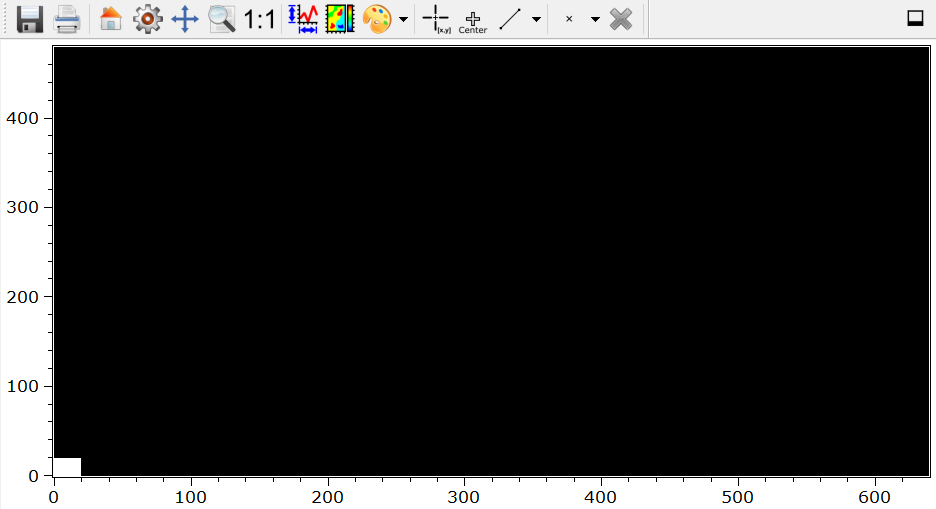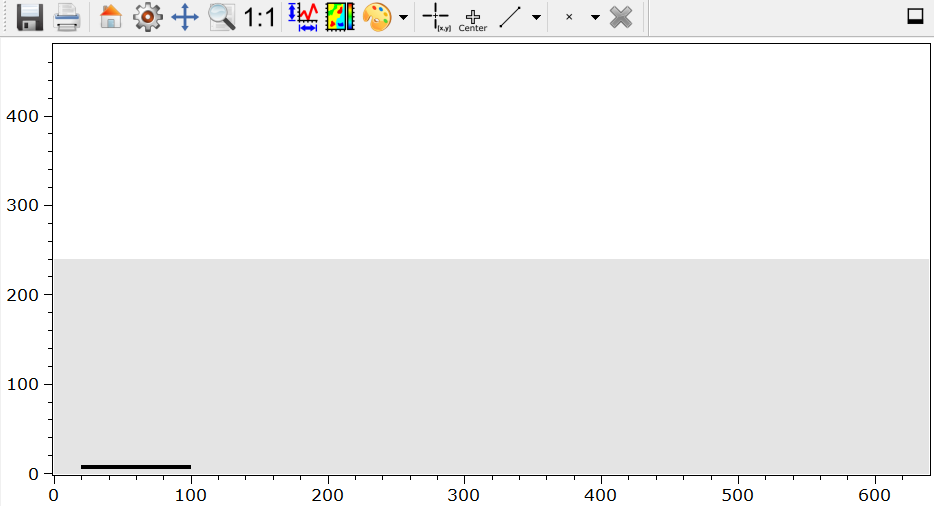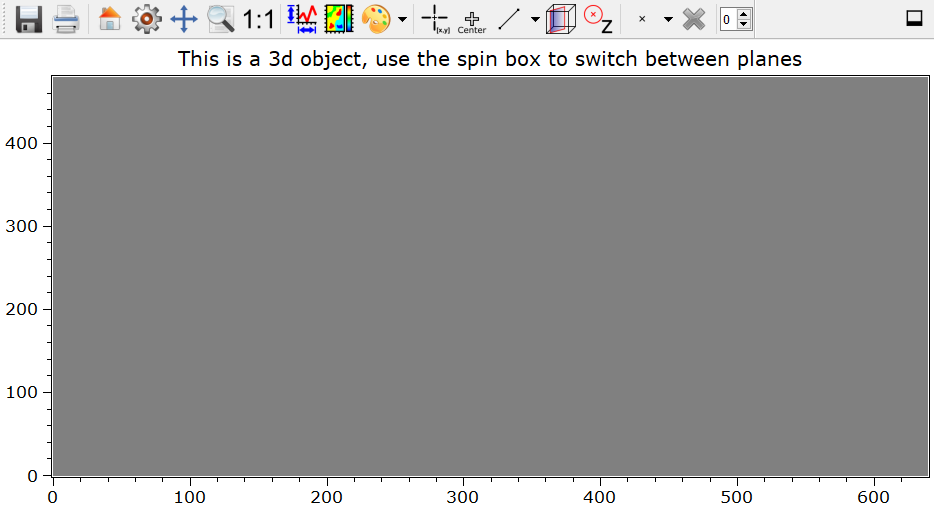Note
Go to the end to download the full example code.
12.1.10.1.2. DataObject#
This demo shows some basic features of the itom dataObject.
from itom import dataObject
from itom import plot
# some constants
yDim = 480
xDim = 640
zDim = 10
Creation of several data objects
# empty dataObject
objEmpty = dataObject()
# a one-dimensional dataObject does not exist, always create a 1xM or Mx1 instead
obj2dim = dataObject([yDim, xDim], "float64")
obj3dim = dataObject([zDim, yDim, xDim], "uint16")
# Special constructors for zero, ones, eye and randomly filled objects
objZero = dataObject.zeros([yDim, xDim], "float64") # 2D object filled with zeros
objOnes = dataObject.ones([yDim, xDim], "float64") # 2D object filled with ones
objEye = dataObject.eye(4, "uint8") # 4x4 matrix
objRand = dataObject.rand(
[yDim, xDim], "uint8"
) # 2D object filled with uniformly distributed random values
objRandN = dataObject.randN(
[yDim, xDim], "uint8"
) # 2D object filled with Gaussian distributed random values
Hint
the methods rand and randN create values in the full data range for integer based data types whereas the randomly distributed values are in the range [0,1) for floating point data types.
Type conversion
objRandFloat = objRand.astype("float64")
Assign values to data objects
# fill the upper half of the object with 5.7 (the operator // makes an integer division)
obj2dim[0 : yDim // 2, :] = 5.7
# fill the bottom half of the object with 6.6 (the operator // makes an integer division)
obj2dim[yDim // 2 :, :] = 6.6
# fill a selected rectangle with -2.0
obj2dim[5:10, 20:100] = -2.0
# fill the entire 3d object with zero
obj3dim[:, :, :] = 0
# replace the 2nd plane of the 3d object by the random values of the casted object
obj3dim[1, :, :] = objRand.astype(obj3dim.dtype)
Delete objects
del objRandFloat
Shallow copies
Python has the concept to share as much memory as possible between different objects. This also holds for dataObjects. In some cases, e.g. a change of type, shared memories can not be kept, such that an implicit separation of both objects is done. If two objects are shallow copies to each other, the memory as well as tags and other meta information is shared. However, one object can be a sub-slice, so called region of interest (ROI), of the other one, such that the size of the object is individual for each object.
# both variables point to exactly the same dataObject in memory (everything shared)
objZero2 = objZero
# objZero3 is a shallow copy of objZero with the same matrix size
objZero3 = objZero[:, :]
# objZero4 is a shallow copy including a region of interest to the first 20 rows and columns
objZero4 = objZero[0:20, 0:20]
# change the values in the first 20 rows and columns of objZero4 to 5
objZero4[:, :] = 5
# (hence, objZero, objZero2 and objZero4 are changed, too). Proof:
plot(objZero) # opens a 2d plot of objZero
(105, PlotItem(UiItem(class: Itom2dQwtPlot, name: plot0x0)))

Deep copy If you want to have a deep copy, with separated memory and meta information of a dataObject, use the copy-operator’’’
obj2dimCopy = obj2dim.copy()
plot(obj2dimCopy)
(106, PlotItem(UiItem(class: Itom2dQwtPlot, name: plot0x0)))

Accessing values
print("objZero at index 0,5 (row, column):", objZero[0, 5])
# get the first five values of the first row of objZero:
vals = objZero[0, 0:5] # the last value of a slice is always EXCLUDED from the slice
# vals is now a dataObject, however it can be converted to a tuple:
print("first five values of objZero:", vals.value)
objZero at index 0,5 (row, column): 5.0
first five values of objZero: (5.0, 5.0, 5.0, 5.0, 5.0)
Axis scaling, offset, description and unit
every dataObject can have meta information for each axis. The scaling represents unit/px and gives the physical representation of the axis The offset is the offset of the first value in this axis, given in pixel The transformation between pixel and physical coordinates is then: phys_coord = (px_coord - offset) * scaling
obj2dim.axisScales = (0.1, 0.1) # 0.1 mm / px
obj2dim.axisOffsets = (0, 100) # the x-axis starts now at -10mm (100 * 0.1)
obj2dim.axisUnits = ("mm", "mm")
obj2dim.axisDescriptions = ("y-axis", "x-axis")
obj2dim.setTag("title", "obj2dim Title")
obj2dim.valueUnit = "\xb0" # this is a special character. To allow this, the first line of this script is relevant (right click -> insert codec)
obj2dim.valueDescription = "phase"
plot(obj2dim, properties={"colorBarVisible": True})
(107, PlotItem(UiItem(class: Itom2dQwtPlot, name: plot0x0)))

Tags
It is possible to add string or double valued tags to each dataObject. There are some special tags, that can directly be interpreted by plots (e.g. the ‘title’ tag). All other tags can be used for any purpose.
obj3dim.setTag(
"title",
"This is a 3d object, use the spin box to switch between planes",
)
plot(obj3dim)
(108, PlotItem(UiItem(class: Itom2dQwtPlot, name: plot0x0)))

# Set additional information (meta data) as tags
# Use set tag "key", "value". Key / value are user defined.
obj2dim.setTag("Creator", "itom")
obj2dim.setTag("Type", "Measurement")
obj2dim.setTag("DummyTag", "Delete Me")
# Retrieve tags by their key and print them
print(obj2dim.tags["Creator"])
print(obj2dim.tags["Type"])
# Get the complete tag space as a python dictionary
tagdic = obj2dim.tags
# Get the size of the tagspace
print(obj2dim.getTagListSize())
# or
print(len(tagdic))
# List up all tags in the tagspace
print("\nMy Taglist")
for key in tagdic.keys():
print(key + " -> " + obj2dim.tags[key])
# Delete a tag
obj2dim.deleteTag("DummyTag")
# List up all tags in the tagspace
print("\nMy Taglist")
for key in obj2dim.tags.keys():
print(key + " -> " + obj2dim.tags[key])
# The dataObject has a protocol function. It is a tag and many filters in c++ add their properties after computation to this string by using addToProtocol
# Add a protocol to the Object, if object is a ROI-ShallowCopy the ROI is automatically added to the protocol-String
print("\nProtocol function:")
obj2dim.addToProtocol("Created today for test reasons")
# Read protocol string
print(obj2dim.tags["protocol"])
itom
Measurement
4
4
My Taglist
Creator -> itom
DummyTag -> Delete Me
Type -> Measurement
title -> obj2dim Title
My Taglist
Creator -> itom
Type -> Measurement
title -> obj2dim Title
Protocol function:
Created today for test reasons
Total running time of the script: (0 minutes 0.266 seconds)
